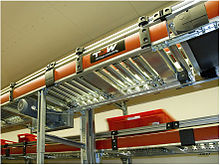Continuous conveyor

A continuous conveyor or elevator is an in-house conveyor system . It creates a continuous transport stream.
tasks
They are suitable for transporting large amounts of material or continuously required materials on fixed routes, whereby loading and unloading can take place at several points along the transport route. They are constantly (constantly) in motion, in contrast to the discontinuous conveyors , which move the transported goods in individual cycles. Continuous conveyors are available as floor-bound or floor-free systems. Floor-bound vehicles are able to transport the goods to be transported horizontally, inclined and vertically. They often require a lot of space on the floor and have a fixed transport route. Overhead systems are rail-bound in most areas of use.
Continuous conveyors are often of a simple design and do not need anyone to operate them because they are automated. The investment and maintenance costs depend on the design and the route to be bridged. They can be considerably larger than the use of a discontinuous conveyor (e.g. setting up a conveyor belt system versus using trucks as a means of transport for bulk goods). The drive of the continuous conveyor is intended for continuous operation and is mostly just a drive that has a simple design and low energy consumption as well as high operational reliability. The long-term savings are achieved through relatively low operating and wage costs, however, when the system is expanded, difficulties can arise in terms of performance and changes in tasks.
Continuous conveyors are used, among other things, for the delivery and removal of material and products in the chemical industry, in mining, open-cast mining, the metalworking industry, in power plants, in the production process, in the storage area, in the automotive industry and when connecting individual production processes.
Continuous conveyors are divided into three main groups:
- Belt conveyor
- Link belt conveyor
- Slip
Examples

-
Mechanical conveyor
- Roller conveyor with drive
- Vibratory conveyor (also discontinuous conveyor depending on the operating mode)
- Circular conveyor
- Circulating conveyor ( paternoster )
- Belt conveyor
- Rotary valves
- Belt bucket elevator
- Chain conveyor
- Screw conveyor
- Also circulating cable cars (eg. As circulating material ropeways ) are continuous conveyors.
-
Gravity conveyor
- Spiral slide
- Roller track , roller track , marble track , rail track (without drive)
-
Flow conveyor
- pneumatic conveying (transport fan for bulk goods), see also grain elevator
- hydraulic conveyance ( pipeline )
- Continuous conveyor for passenger transport
literature
- Walter Meyercordt: Continuous conveyor - primer. Hageneier, 1968.
- Dirk Jodin, Michael ten Hompel: Sorting and distribution systems, basics, structure, calculation and implementation. ISBN 3-540-29070-2 .
- Willibald A. Günthner, Klaus Heptner: Technical innovations for logistics. ISBN 978-3-937711-54-6 .
- Heinrich Martin: Transport and warehouse logistics, planning, structure, control and costs of intralogistics systems. 6th edition. ISBN 3-8348-0168-2 .
Individual evidence
- ↑ Conveyor roller tests for manufacturers and users of conveyor rollers. Retrieved July 10, 2018 .
